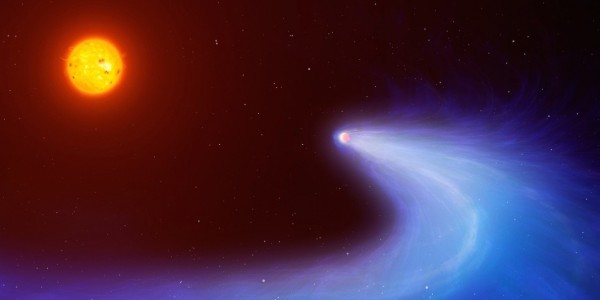What the “comet planet” tells us

Gliese 436b (also called GJ 436b) could perhaps explain the past of our atmosphere and its future. This planet that looks like a comet because of its huge hydrogen tails arouses great interest among several PlanetS astronomers. They have just demonstrated in an article in “Nature” that the hydrogen contained in the planet’s atmosphere is evaporated by its star. They speculate that this could explain the existence of hot super Earths. It is still unclear how such rocky planets may form so close to their stars.
[jwplayer mediaid=”10000″] According to David Ehrenreich and Vincent Bourier, both astronomers at the Geneva University, hot Neptunes (as Gliese 436b) could migrate towards their star and lose their atmosphere by evaporation once they get close enough. The mechanism is more efficient when the star is brighter and the planet is lighter. Rocky planets very close to their stars, like the famous Super Earths detected by Kepler, could therefore be left overs of hot Neptunes after they lost their complete atmosphere. This mechanism could also have played a role on our planet by evaporating the hydrogen which was present in the atmosphere during its first 100 million years of existence. Also, after our Sun becomes a red giant at the end of its life, our atmosphere could be lost in a similar process.Gliese 436b, the future
These assumptions, even if they seem likely, are however only based on the observation of a single planet. To further support their theory, astronomers of PlanetS have asked for additional observing time on the Hubble Space Telescope to study other objects similar to GJ 436b. Hubble is indeed the only instrument capable of such observations as, during the transit, the cloud surrounding the “comet planet” absorbs light from the star mainly in the ultraviolet, which makes it necessary to measure outside of the Earth’s atmosphere that is blocking UV light to a great extent. They were also granted more time on the same instrument to re-observe GJ 436b. During the first campaign they could observe the exoplanet only 3 hours before and 4 hours after the transit, which prevented them to obtain a good idea of the size of the cloud. Other important data to better understand the mechanism are the pressure radiation of the star and the effect of the stellar wind. (pb/tr)
Categories: External Newsletter
